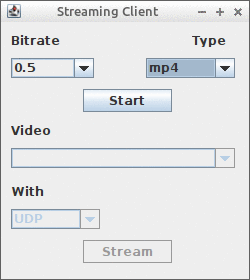A 3-part Java application of video streaming and management using the FFMPEG tool and wrapper.
In more detail, the application is divided into 3 apps:
- Streaming Director, which given every video file in the
raw_videosdirectory, generates different video editions with different formats (avi, mp4, mkv) and different bitrates (200Kbps, 500Kbps, 1Mbps, 3Mbps) each and stores them in thevideosdirectory. - Streaming Server, which is responsible for the management and streaming of videos that are available based on the client's specifications.
- Streaming Client, which is responsible for the communication with the server and playing the video streamed video that was selected by the end user.
- Scanning the
/raw_videosdirectory for videos - Generating 12 different files (with differences in the file format and/or the bitrate) for each video (using the
)
- Saving the generated videos to the
/videosdirectory - Deleting all videos from the
/raw_videosdirectory
- Waiting and receiving a client request (that contains the selected bitrate and file format by the end user)
- Creating a list from the videos in the
/videosdirectory that match the info given by the request (every video with this particular format and smaller or equal bitrate to the one chosen) - Sending this list of video names to the client
- Receiving the response of the client (that contains the selected video from the list, along with a given network protocol of TCP, UDP, RTP/UDP)
- Streaming the selected video through the given protocol to the client (by creating a ffmpeg.exe process in the local system)
- Sending the initial request to the server (that contains the selected bitrate and file format by the end user)
- Receiving the server's response with the list of filenames for the videos that meet the criteria of the user
- Sending the final request to the server with the stream specifications (that contains the selected video from the list, along with a given network protocol of TCP, UDP, RTP/UDP)
- Receiving the selected video that is being streamed and presenting it to the end-user (by creating a ffplay.exe process in the local system)
- Every app/part of the project is written in a way that its implementation and operation is strictly contained to one class/file.
- The project assumes that you have FFMPEG installed under
/usr/bin/in Linux. - There is no check whether the files inside
/raw_videosare actual videos or not. - For the RTP/UDP network protocol, the
video.sdpfile with the essential stream characteristics is located locally inside the project. - The video stream might seem like "freezing" after a few tests. This is not the project's fault. FFMPEG is really not that optimised for this kind of tasks.



